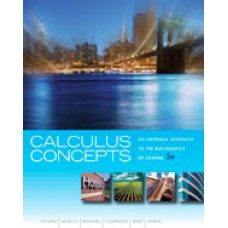Test Bank for Calculus Concepts An Informal Approach to the Mathematics of Change, 5th Edition
$35.00 Original price was: $35.00.$26.50Current price is: $26.50.
Test Bank for Calculus Concepts An Informal Approach to the Mathematics of Change, 5th Edition
Instant download Test Bank for Calculus Concepts An Informal Approach to the Mathematics of Change, 5th Edition pdf docx epub after payment.

Product details:
- ISBN-10 : 1439049572
- ISBN-13 : 978-1439049570
- Author: Donald R. LaTorre; John W. Kenelly
This innovative text features a graphing calculator approach, incorporating real-life applications and such technology as graphing utilities and Excel spreadsheets to help students learn mathematical skills that they will use in their lives and careers. The texts overall goal is to improve learning of basic calculus concepts by involving students with new material in a way that is different from traditional practice. The development of conceptual understanding coupled with a commitment to make calculus meaningful to the student are guiding forces. Targeted toward students majoring in liberal arts, economics, business, management, and the life and social sciences, the text’s focus on technology along with its use of real data and situations make it a sound choice to help you develop an intuitive, practical understanding of concepts.
Table of contents:
1. INGREDIENTS OF CHANGE: FUNCTIONS AND LIMITS. Functions–Four Representations. Function Behavior and End Behavior Limits. Limits and Continuity. Linear Functions and Models. Exponential Functions and Models. Models in Finance. Constructed Functions. Logarithmic Functions and Models. Quadratic Functions and Models. Logistic Functions and Models. Cubic Functions and Models. Cyclic Functions and Models. Representations of a Sine Function. Characteristics of Sine Functions.
2. DESCRIBING CHANGE: RATES. Measures of Change over an Interval. Measures of Change at a Point. Rates of Change–Notation and Interpretation. Rates of Change–Numerical Limits and Non-existence. Rates of Change Defined over Intervals. Sketching Rate-of-Change Graphs.
3. DETERMINING CHANGE: DERIVATIVES. Simple Rate-of-Change Formulas. Exponential, Logarithmic, and Cyclic Rate-of-Change Formulas. Rates of Change for Functions That Can Be Composed. Rates of Change of Composite Functions. Rates of Change for Functions That Can Be Multiplied. Rates of Change for Product Functions. Limits of Quotients and L’H�pital’s Rule.
4. ANALYZING CHANGE: APPLICATIONS OF DERIVATIVES. Linearization. Relative Extreme Points. Relative Extreme Points. Inflection Points and Second Derivatives. Marginal Analysis. Optimization of Constructed Functions. Related Rates.
5. ACCUMULATING CHANGE: LIMITS OF SUMS AND THE DEFINITE INTEGRAL. An Introduction to Results of Change. Limit of Sums and the Definite Integral. Accumulation Functions. The Fundamental Theorem. Antiderivative Formulas for Exponential, Natural Log, and Sine Functions. The Definite Integral–Algebraically. Differences of Accumulated Change. Average Value and Average Rate of Change. Integration of Product or Composite Functions.
6. ANALYZING ACCUMULATED CHANGE: INTEGRALS AND ACTION. Perpetual Accumulation and Improper Integrals. Streams in Business and Biology. Calculus in Economics–Demand and Elasticity. Calculus in Economics–Supply and Equilibrium. Calculus in Probability–Part
1. Calculus in Probability–Part
2. Differential Equations–Slope Fields and Solutions. Differential Equations–Proportionality and Common Forms.
7. INGREDIENTS OF MULTIVARIABLE CHANGE: FUNCTIONS AND RATES. Multivariable Functions and Contour Graphs. Cross-Sectional Models and Rates of Change. Partial Rates of Change. Compensating for Change.
8. ANALYZING MULTIVARIABLE CHANGE: OPTIMIZATION. Extreme Points and Saddle Points. Multivariable Optimization. Optimization Under Constraints. Least-Squares Optimization. Answers to Odd Activities. Index of Applications. Subject Index.
People also search:
Calculus Concepts An Informal Approach to the Mathematics of Change, 5th Edition
Calculus Concepts An Informal Approach to the Mathematics of Change, 5th Edition pdf
Calculus Concepts An Informal Approach to the Mathematics of Change
calculus concepts an informal approach
calculus concepts an informal approach to the mathematics of change ebook
Related products
Test Bank
Test Bank for Decision Support and Business Intelligence Systems, 9th Edition: Efraim Turban











